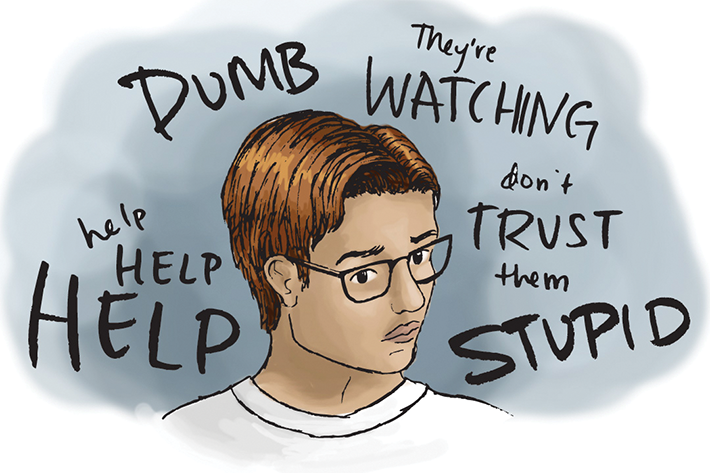#ThrowbackThursday: Mental health survey at Cal State Hayward
April 23, 2015
By Sandy Barnett
July 12, 1989
A recent study here on campus examining student attitudes toward mental health concluded that many people continue to attach a negative stigma toward mental illness.
The study conducted last quarter by CSUH sociology major Sylvia Wright, questioned 134 students about their attitude toward mental illness.
The result of the study seem to indicate that when a person is labeled “mentally ill,” it strongly affects the reaction other people have toward them. The study also indicated that the majority of students are wary of trusting a person with mental illness.
When asked if they would hire a person just released from a mental institution, just over half said they didn’t know, with only one out of 10 stating that they probably would.
“The people who have the most prejudice against mental health care are people who have not been in the mental health system,” says John Ouse, a staff counselor at Cal State’s Counseling Center in Warren Hall.
If a person is in enough distress that they feel the need to seek professional help, the state “becomes” less stigmatized for them and they have less prejudice against it,” said Rouse, “whereas that person who never gets to the place where they need to see somebody professionally, their attitudes can still be fairly entrenched.”
Rouse cited a nationwide study conducted by the National Institute of Mental Health focusing on attitudes about mental health.
The study found that 30 to 40 percent of those questioned had been distressed enough to seek counseling, but due to their misconceptions about mental health only six to 10 percent actually went to see someone.
In the study conducted here on campus, not all students had a negative reaction to mental illness, however.
When asked if they agreed with the phrase” Once a mental patient, always a mental patient,” most students disagreed, indicating that there is some knowledge that mental illness is not a permanent condition and can be cured.
Most students also disagreed that individuals with mental illness remain dependent on mental health services indefinitely.
Rouse concurred, saying that the belief that once a person is mentally ill, he or she will always be dependent on the system is a “ faulty conception.”
The results of the campus study indicate that the reactions of the students were tied to their experience or lack of experience with the mentally ill.
Rouse feels that the way the media portrays mental illness could also contribute to the misconceptions people have about the mentally ill. “It has a lot to do with positive exposure as opposed to negative exposure.”
Update: The stigma of mental health
By Bryan Cordova
Managing Editor
People with any kind of mental illness are still stigmatized and associated with aggression in today’s society. A majority of the news portrays people with mental illness as dangerous and characters portrayed in entertainment follow the same stereotype.
One of the most popular shows airing now is Bates Motel, which chronicles the teenage years of iconic character Norman Bates. Set as the prequel to the 1950s classic movie “Psycho,” arguably the start of the slasher film genre, Bates is a schizophrenic man who dresses as his mother and murders guests in his hotel. The film received critical acclaim, four Academy Awards, and was deemed by the US Library of Congress as “culturally, historically, and aesthetically significant.”
The movie itself did not start the stigma towards people with schizophrenia, but it is one of the earliest examples of the culture of violence that surrounds the mental illness. Bates displayed a violent nature, and was a dangerous person who happened to have a violent type of schizophrenia.
The National Institute of Mental Health defines schizophrenia as a disabling brain disorder that causes people to hear voices inside their head.
People with the disorder may believe people around them are reading their minds, controlling their thoughts, or plotting to hurt them, which can lead to fear and agitation but most people with schizophrenia do not commit violent crimes, according to the NIMH.
The American Psychology Association published a study of crime rates in 2014 that revealed 4% were directly related to symptoms of schizophrenia disorders.
“When we hear about crimes committed by people with mental illness, they tend to be big headline-making crimes so they get stuck in people’s heads,” wrote lead researcher of the study Jillian Peterson, PhD. “The vast majority of people with mental illness are not violent, not criminal and notdangerous.”
The rate of violence against others is smaller than the rate of suicide amongst people with the illness. About 10 percent of people with schizophrenia die by suicide, but it’s still hard to predict which schizophrenia type is more prone to suicide, according the NIMH.
There are different types of schizophrenia:
— Paranoid, which leads people to feel suspicious, persecuted, and judged.
— Disorganized, where a person is incoherent in speech and thoughts.
— Catatonic, when a person is mute, negative, and moves their body into unusual positions.
— Residual, where a person no longer experiences delusions or hallucinations but loses their interest in participating in life.
— Schizoaffective, a dual disorder where a person has both schizophrenic symptoms and depression.
There is no cure for schizophrenia yet, but with proper treatment many people with the illness can live productive and fulfilling lives.
















